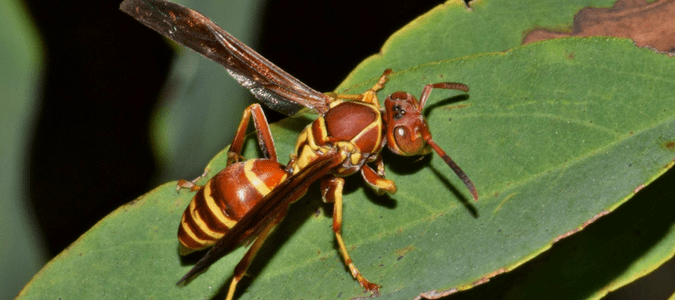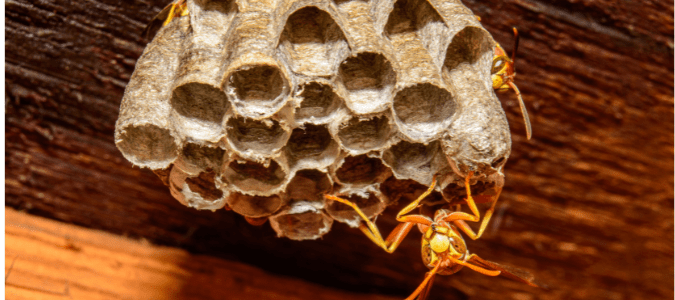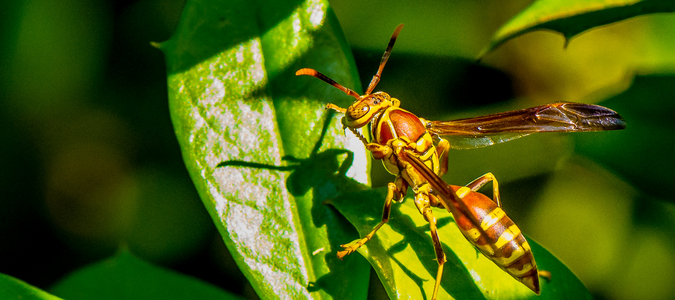Just the word “wasp” can make most people shudder, as it brings to mind a fear of getting stung. It can be difficult to know whether or not the flying insect you see threatens you and your loved ones. Once you spot them, you want them gone as soon as possible. But before you do, here is some information on identifying wasps and how they live.
Some types of wasps can be beneficial, and that includes paper wasps. If you like to garden, especially if you grow vegetables and flowers, the presence of these wasps might be a welcome sight. These social wasps feed on other insects that can harm the things you grow. How do you know if the buzzy bugs you see are the “good” kind? Check their markings. Or contact a pest control expert who can assess the population and let you know if you have anything to worry about.
There are many varieties of paper wasps. They all tend to be from a half-inch to an inch long and mainly brown with yellow markings. Some of them have reddish markings or a black main body color. These types do share some physical characteristics. Their body shape is long and narrow, and they let their legs dangle when they fly. All paper wasps’ wings also fold lengthwise when they are at rest. They are sometimes confused with yellowjackets or baldfaced hornets, but their nests are very different.
Do Paper Wasps Sting?
If you are concerned about getting stung when you come across paper wasps, you can rest easy–for the most part. They do sting, but only if they feel their nest is threatened. If you see paper wasps away from the nest, they are likely gathering food and will not bother you. The wasps hunt for food during the day and then sleep on the nest at night.
If you are wondering if wasps bite, the good news is that these pests don’t.
Though the chance of being stung by these insects is slim, that doesn’t necessarily mean they don’t do harm in other ways. Sure, they feed caterpillars and other insects that are a menace to gardens and crops to their young. The adult paper wasps, however, will feast on any fruits growing in your garden. That makes them a menace to gardeners who plant those things.
The wasps often build their nests under the eaves of homes and garages or sometimes in buildings, which can be unnerving to many people. Before you try to remove them from your property, it’s a good idea to identify the nest. This way, you know whether you have anything to worry about.
Paper Wasp Nest
As mentioned, their nests are distinctively different from other types of wasps. They are hexagon shaped with an open structure, unlike other wasps’ nests with a cap or cover. The nests are typically gray in color, with single cells in a single layer and they hang down from a single stalk.
The wasps use fiber from benches, posts or other untreated wood, and sometimes they use pulp from live plant stems, which can harm the plants. The adult wasps mix the fiber with their saliva to create the nests. When fully mature, a nest could have as many as 200 cells! If you are unsure whether the nest you found is from paper wasps or another type that might be more harmful, call in a pest control professional who knows how to get rid of wasps. They can tell you what has taken up residence near you and recommend a treatment plan.
Spotting a Paper Wasp Nest
If you notice the nest in late fall, you might not need to seek any treatment. That is because almost all the nest’s inhabitants except the queen die in the winter. If you see the nest in the winter, remove it to discourage the next round of wasps from setting up residence there in the spring. Knock it down with a broom if you can reach it easily. You also can use a high-pressure stream of water to remove the nest.
Spotting an active nest in spring or summer is another story. This is a good time to seek professional help. If you want to remove the nest yourself, remember that the worker wasps not out looking for food at that time will sting when they feel the nest is being threatened. It is important to note that the wasps’ behavior varies by day and night and by temperature. Be aware that if you see large amounts of these wasps flying around, don’t get too close!
If you get stung by a paper wasp or wasps, it’s helpful to know that the main effect is soreness and localized swelling. However, some people are highly sensitive to insect stings, and the effects can be much more severe for them. In cases where a person receives many stings, the effects will also be intense and may require medical attention.
Once a nest has been removed from a specific spot, you may see a new nest take shape the following spring. If you notice that paper wasps are taking up residence at the same place year after year, you can take steps to make it more difficult for them to move in.
To keep wasps from returning to nest in your attic, add a screen that will prevent them from entering. If you have shrubs around your home, keep them well-trimmed and properly thinned to discourage nest-building.
Paper Wasp Queen Versus Worker
Young female wasps that mate in the fall then look for a safe, protected place to snuggle in for the winter, such as an attic or a hollow tree. They might spend the winter alone, or if their found home is large enough, they might have the company of dozens of other females.
When the weather warms up in the spring, these female wasps emerge and look for a new home. The founding queens will look for a spot protected from rain and other unpleasant weather, such as the eaves or porch of a home. Then they gather the fiber from untreated wood and build the nest. Usually, there is just one queen per nest. Occasionally, a couple of queens will settle into the same nest.
The queen deposits some of her eggs into the small starter nest and feeds them caterpillars and other insects. Each cell of the nest contains just one egg, which goes through several stages of development before maturing enough to leave the nest. When the nest is small at this stage, it is a good time to remove it. Waiting until it is large and home to many wasps only increases the chances of getting stung. Call in a pest control professional in the spring and have them do an inspection to uncover nests you might not have seen before they become a problem.
Once the eggs develop into young wasps, they emerge and get to work, taking over nest-building from the queen. Sterile worker wasps become the builders. They also take on feeding other developing eggs in the ever-growing nest.
The queen stops producing eggs by fall, and the nest population declines. The young females head out to mate before the cold weather sets in. Once the chill hits, the mated females find their new living space for the winter, and the males die. The cycle starts all over again.
ABC Can Treat the Wasp Nests on Your Property
Having a wasp nest on your property can be frightening. Instead of trying to handle the problem on your own, contact ABC Home & Commercial Services. Our pros can offer advice on what attracts wasps, and we can effectively remove these pests, so you don’t have to worry about painful stings.



